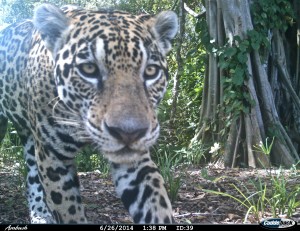Largest cats of the Americas were caught mating by camera traps in an oil palm landscape
In the Magdalena River valley of Colombia
Bogotá, Colombia – The photos and videos of jaguars mating were taken by camera traps in a highly modified agricultural region with oil palm plantations in the Magdalena river valley of Colombia, as part of the PhD project of Valeria Boron, enrolled at the Durrell Institute of Conservation and Ecology (DICE), University of Kent, UK (www.kent.ac.uk/dice/) and working in close collaboration with Panthera, the world-leading cat conservation NGO (www.panthera.org). The project aims at furthering our understanding on how to conserve jaguars across increasing oil palm landscapes in Colombia, and it is supervised by Dr. Joseph Tzanopoulos and Prof. Douglas MacMillan in the University of Kent, and by Dr. Esteban Payan, Director of Panthera’ s Northern South America Jaguar Program. Two local biologists, Laura Jaimes Rodriguez and Andres Quiñones are also part of the team.
“It is key to understand how jaguars use human-dominated landscapes, and how oil palm cultivation affects them because the future of large carnivores like jaguars cannot rely on protected areas alone as they are simply not large enough. Their conservation requires instead a landscape approach to ensure genes flow between core high quality habitats through corridors in human dominated areas, as Panthera’s Jaguar Corridor Initiative promotes (www.panthera.org/node/27)” Dr. Esteban Payan explains. Colombia, is an area where efforts would significantly contribute to a range-wide jaguar conservation because it connects jaguar populations between Central and South America. However it is also the world’s fifth largest palm oil producer and the industry is due to expand significantly fostered by national policy and increasing market demand. Palm oil and its derivatives are indeed used in a wide spectrum of products from edible oils to ice creams, cosmetics, animal feed, and biofuels. It is estimated for example that one out of ten products in a UK supermarket contains palm oil.
Currently 80% of palm oil is produced in Malaysia and Indonesia, but 410–570 million ha of currently forested land across Southeast Asia, Latin America and Central Africa are suitable for oil palm cultivation and might be converted as the demand rises.This poses a significant threat for jaguars because palm oil plantations are poor habitats for many species, including tigers, and to date information on the impact of these plantation on jaguars is extremely scarce, making land use plans and conservtaion strategies difficult to develop.

Image courtesy of Valeria Boron
We are conducing research on the species in an oil palm landscape using camera traps as they a are great tool to study secretive species like jaguars, otherwise difficult to observe. The cameras, activated by motion and heat, photo-capture all passing wildlife gathering precious information on a number of species. The camera capturing Courage and Amistad (Spanish for “friendship”) mating was set on a trail sourrounded by wetlands and small scale cultivation, suggested to us by Adolfo Rangel Ortiz, a local land owner, who said they had repeatedly observed jaguars footprints there. When we saw the photos and videos we were happy beyond expectations.. not only the trail was right, the exact camera location could not have been better! It is great to capture such majestic animals mating, indicating there is hope for their conservation in the area. We will leave cameras there until March 2015 to see if you can photo-captures the future cubs.
From camera trap photos we are able to recognise single jaguar individuals by their unique pelage pattern. Since April we have photo-captured at least nine different individuals in an area of over 100 sq km which is an encouraging result given how highly modified the landscape is. We have also photo-capture important jaguar prey species such as capybaras, armadillos, pacas, and giant anteaters. We suggest that jaguars are able to co-exist with human-dominated agricultural landscapes and even with oil palm plantations if natural areas and wetlands still remain in the landscape. This could be achieved through incentives for multi-crop farms and agroforestry, enforcement of land use plans, tax breaks conditional to creating conservation areas and respecting environmental laws, and establishment of premium prices to increase motivation for oil palm growers to obtain certifications through the Roundtable on Sustainable Palm Oil (RSPO). With an ever growing human population natural ecosystems will continue to be converted, hence understanding how to conserve jaguars in unprotected and modified areas like this one is key for their survival.
About jaguars: The jaguar, Panthera onca, is the largest felid species in the Americas, it ranges from Mexico to Argentina but it has disappeared from 54% of its historic range. Jaguars are considered Near Threatened by the International Union for Conservation of Nature (IUCN) and they are continuously declining because they are particularly vulnerable to habitat loss due to their large area requirements, low densities and slow population growth rates. Furthermore, they are also vulnerable to persecution which nowadays is predominantly in form of retaliatory kills following predation of livestock since the trade in jaguars skin declined drastically after the mid-1970s, when CITES regulations were enforced.

Image courtesy of Valeria Boron
Why conserving jaguars? Jaguars have a strong cultural, spiritual and inspirational value dating as far back as pre-Columbian civilizations in Central and South America. They also play a key role in mainting healthy ecosystems: by limiting populations of herbivorous mammals, they play an important role in maintaining forest structure, which is ultimately connected to important ecosystem services we all benefit from, such as water regulation. In addition, from a conservation perspective, focusing on species like jaguars is effective because to conserve them it is necessary to conserve their prey species as well and the large areas they need, ultimately protecting entire ecosystems.
Project Funding: Liz Claiborne Art Ortenberg Jaguar Research Grant, Rufford Small Grants, Idea Wild, The Explorers Club.
Report by Valeria Boron, valeria.boron@gmail.com

